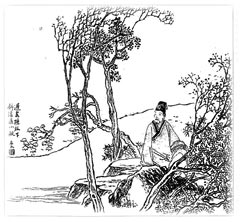Origins and Ideological Sources of Religious Taoism

By Liu Feng, Lao An, etc.
1. The Origin of china’s Primitive Religious Cults
2. Religious Taoism in Relation to the Yin-yang and Five Elements Theory
3. Religious Taoism in Relation to the Doctrine of Immortality and the Occult Science
2. Religious Taoism in Relation to the Yin-yang and
Five-agent:: Theories
In the course of its rise and development, religious Taoism was considerably influenced by the belief in the deities of the five realms, which was the child of the marriage of the yin-yang and five elements theories with the worship of ghosts and spirits prevalent in ancient China. Before the time of the Spring and Autumn Period and the Warring States Period, the five agents, i. e. water, fire, wood, metal and earth, whose specific features and functions were recogonized by the ordinary people through their long-term social practice, were merely material elements and did not imply the connotation of any property of social morality, just like what is stated in the Book of History, the five elements “are water, fire, wood, metal and earth. The water soaks; the fire blazes; the wood grows, either crooked or straight; the metal smelts; and the earth yields crops.” It testifies that the so-called five elements originally referred to the five basic elements which constitute all the things and each of which has its own specific property and function.
However, during the Warring States Period, there emerged in China the yin-yang and five elements school represented by Zou Yan of the State of Qi. This school of philosophy combined the five virtues theory with the yin-yang and five elements theories and, after deifying them, they employed the combined theory in expounding the laws of the changes in Heaven’s way and human affairs and the cause and trend of the changes of the dynasties. Besides, they explained the seasonal changes in terms of the rise and fall of the yin and yang qi, and interpreted the flourishing and declining of the dynasties as the successional generation and overcome of the five elements. They held that it was in accordance with the cycle of the successional overcome of the five elementss that the human society developed itself.
| Video: Taoism – Part Two |
The prosperity of the empire would necessarily show in advance auspicious omens and would take one of the five elements as the qi and color they set great store by. For instance, the establishment of the Yellow Emperor was heralded by the presence of huge-sized earthworms and mole crickets, with the prevalence of the qi of earth and the yellow color being valued, and the rule would be troubled and overcome by wood. Before the reign of King Tang of the Shang Dynasty, there was a gold sword emerging in water, the qi of metal prevailed and the white color was esteemed, while before the reign of king Wen of the Zhou Dynasty, there were red birds carrying red books between their beaks and gathering over the community of the Zhou House, the qi of fire prevailed, the black color was esteemed, and the future trouble of the empire would be of water Hence, the five virtues were determined by the presence of auspicious omens in accordance with the will of Heaven, and everything was prearranged by Heaven.
In the classic the Spring and Autumn Annals, there is a diagram in a strictly regular pattern drawn in accordance with the yin-yang and five elements theories. In this diagram, the directions of the five ancient kings are positioned as follows: the Yellow Emperor is located at the center and is supposed to possess the virtue of earth; Taihao is located in the east, is supposed to possess the virtue of wood, symbolizes spring and is alternately known as the Green Emperor; Yan Di is located in the south, is supposed to possess the virtue of fire, and symbolizes summer, alternately known as the Red Emperor; Shao Hao is located in the west, is supposed to possess the virtue of metal and symbolizes autumn, aiternately known as the White Emperor; and Zhuanxu is located in the north, is supposed to possess the virtue of water and symbolizes winter, alternately known as the Black Emperor.
 During the Qin Dynasty (221 BC – 207 BC), the First Emperor of Qin (Qinshi Huangdi), after he unified the country by force, also followed the doctrine “the five virtues move in an endless cycle” as advocated by the disciples of Zou Yan. It was held that the Zhou Dynasty possessed the virtue of fire and that if the Qin Dynasty inherited that virtue of the Zhou, the rule of the Qin would not be successful. Therefore, the First Emperor of Qin made his rule the beginning of the virtue of water, changed his reign title, and decreed that all the respects to the new emperor to be paid on the first day of the 10th lunar month, all the attires, tallies, emblems and banners to be made in black, numbers to be counted with six as the unit, all tallies and credentials to be made six cun (a unit of length = 1/3 decimeter) long, all carriages to be structured six chi (a unit of length = 1/3 meter) wide and six chi long, the foot to be made up with six chi and six horses to be harnessed to one chariot.
During the Qin Dynasty (221 BC – 207 BC), the First Emperor of Qin (Qinshi Huangdi), after he unified the country by force, also followed the doctrine “the five virtues move in an endless cycle” as advocated by the disciples of Zou Yan. It was held that the Zhou Dynasty possessed the virtue of fire and that if the Qin Dynasty inherited that virtue of the Zhou, the rule of the Qin would not be successful. Therefore, the First Emperor of Qin made his rule the beginning of the virtue of water, changed his reign title, and decreed that all the respects to the new emperor to be paid on the first day of the 10th lunar month, all the attires, tallies, emblems and banners to be made in black, numbers to be counted with six as the unit, all tallies and credentials to be made six cun (a unit of length = 1/3 decimeter) long, all carriages to be structured six chi (a unit of length = 1/3 meter) wide and six chi long, the foot to be made up with six chi and six horses to be harnessed to one chariot.
Besides, the name of the Huanghe River was changed into the “River of Water Virtue,” to mark the starting of the rule by the virtue of water. Moreover, it was stressed that such qualities as intestinal fortitude and rigor were to be cultivated and that everything had to go by laws and regulations. The supposition that the Qin House should rule by the virtue of water was grounded on the legend that in the old days, Duke Wen of Qin had once gone out hunting and captured a black dragon, which was supposed to be the auspicious omen of the virtue of water. Since water was supposed to overcome fire, the House of Qin in possession of the virtue of water should have managed to replace the rule of the House of Zhou which was in possession of the virtue of fire. It was believed that all this happened by the will of Heaven. Herein lies the real meaning of the doctrine followed by the disciples of Zou Yan that the five virtues move in an endless cycle and are applied to explain the replacement of the dynasties.
During the Western Han Dynasty (206 BC – AD 24), the philosopher-statesman Dong Zhongshu rearranged the sequence of the five elements. He strained the interpretations of the successional relationship of overcome of the five elements by analogizing it to the changes in the human society and human affairs. He holds that Heaven possesses the five elements: the first is wood, the second fire, the third earth, the fourth metal and the fifth water, and that wood is the start, while water is the end. Based upon such a sequence, he further expounds the doctrine of successional generation (begetting) between the five elements and analogizes it to the relationship between father and son, as wood generates (begets) fire, fire generates earth, earth generates metal and metal generates water.
Besides, the successional relationship of overcome between the five elements is brought in force between every other elements in the cycle, i.e. , wood overcomes earth, earth overcomes fire, fire overcomes metal and metal overcomes wood. Further more, Dong Zhongshu holds that the locations of the five elements should be that wood is on the left, metal on the right, fire in the front, water in the rear and earth at the center. And then, the corresponding seasons should be: wood located in the east stands for the qi of spring; fire located in the south stands for the qi of summer; metal located in the west stands for the qi of autumn; water located in the north stands for the qi of winter; and earth located at the center stands for all the four seasons. That Dong Zhongshu interpreted the theory of the five elemens in terms of qi rections, locations, seasons and feudalethics was intended to justify the rightness of the feudalist moral codes and order in the interests of the feudalist rulers.
The work Huainan Zi couples the five elements further with the so-calletl five directions, the five divine rulers, the five attendant spirits, the five measurements, the five seasonal periods, the five deities, the five beasts, the five musical scales and the five stems (for marking the days), thus asserting the whole universe being composetl of various “five elements” in a rigid mechanic pattern.
The above table shows clearly that the five legendary forefa thers are listed as five divine rulers (corresponding to the five a gents), assisted by the five attendant spirits, resorting to the five measurements, ruling over the land in the five directions throughout all the seasons, under the protection of the five star deities and resulting in the flourishing of the five beasts and the five musical scales through all the five days. All this symbolizes how the divine spirits of man’s ancestors ruled over the world in the light of the five agents theory. Thus, the five agents were officially deified.
OPENING HOURS
| Week Days | 8:00 – 5:00 |
| Saturday | 9:00 – 5:00 |
| Sunday | 11:00 – 4:00 |




